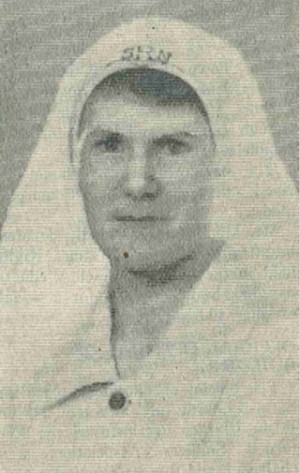
Euphemia Guthrie Lyons
AUNTY JESSIE’S VISIT TO BELTANA
Submitted by Richard Aitken; Ivanhoe, VIC
 It’s hard to know where this started but it was probably a recent clean out at my Melbourne office that saw boxes of old files coming home and a commensurate relocation of my family history files to my father’s place in Bendigo. I agonised whether to put one particular file into cold storage, an album of my great aunt Jessie Aitken relating to her nursing career. As I leafed through to appraise its significance, I came across a letter written in 1984 from ‘Jean’, reminiscing that ‘Guthrie’—who I took to be Jean’s sister—had gone to Beltana in 1936. I immediately recollected a small wallet of snapshots, given to me by my great aunts, showing the Australian Inland Mission there, annotated on the rear: ‘Photos when Jessie went to Beltana’.
It’s hard to know where this started but it was probably a recent clean out at my Melbourne office that saw boxes of old files coming home and a commensurate relocation of my family history files to my father’s place in Bendigo. I agonised whether to put one particular file into cold storage, an album of my great aunt Jessie Aitken relating to her nursing career. As I leafed through to appraise its significance, I came across a letter written in 1984 from ‘Jean’, reminiscing that ‘Guthrie’—who I took to be Jean’s sister—had gone to Beltana in 1936. I immediately recollected a small wallet of snapshots, given to me by my great aunts, showing the Australian Inland Mission there, annotated on the rear: ‘Photos when Jessie went to Beltana’.
‘The Aunts’ were a fixture in our family, referring generally to three unmarried sisters of a family of eight, brought up on a farm north of Bendigo. Jessie had been born in 1902 and her youngest sister Dorothy in 1915. I was extremely fond of both, and of their middle sister Emily, and we worked alongside each other from the late 1970s to sort and date the family’s archive. The Aunts were generous in sharing family lore, but sadly the Beltana visit was never mentioned by Jessie (who died in 1990) and it was left to Dorothy to subsequently pass the wallet of photos to me with an understanding that they were taken about 1938 on a visit to see Jessie’s nursing colleagues, including Guthrie Lyons.
Jean’s letter recalled that Guthrie had stayed at Beltana for more than two years and the close typescript was elsewhere studded with precious nuggets in relation to her upbringing and career. Guthrie had been born in Kienping, Anhwei, China, on 5 December 1911, being educated at the China Inland Mission School at Chefoo, where she passed the Junior Oxford Certificate. She left China in 1927 when the family came to Australia and in 1928 settled at Eaglehawk, where her father had been appointed minister to the Presbyterian Church there. Guthrie did some commercial study by correspondence until she was able to start in the midwifery ward at Bendigo Base Hospital (on 2/6d per week). It was here that she and Jessie Aitken met as student nurses around 1929, graduated together in 1932, and hence enjoyed a reunion some years later at Beltana.
My curiosity piqued, I leapt onto the computer to discover that Frontier Services, and its forerunner the Australian Inland Mission, was celebrating its centenary this year. A few quick keystrokes soon located a notice (in the Victoria Government Gazette) detailing the change of address during 1936 of newly registered midwife Euphemia Guthrie Lyons to ‘Mitchell Home, Beltana, S.A.’ Emboldened I next went to Trove, the wonderful portal of the National Library of Australia, which houses its digitised newspaper archive. Entering the keywords ‘Aitken’ and ‘Beltana’ yielded astonishing paydirt in the Adelaide Advertiser.
Under ‘Reports from rural centres’ for 19 July 1937, the Beltana budget of news noted ‘Sister Aitken, of Bendigo, Victoria, is on a holiday with Sisters Lyons and Buckley, of the Australian Inland Mission Hostel.’ Perhaps it was a short news week. And as if this was not enough, on 9 August the report was repeated and embellished: ‘Sister Aitken, who has been on holidays here for the last three weeks, left by train for her home in Bendigo. Sister Aitken has been the guest of Sisters Buckle and Lyons at the Australian Inland Mission Hostel.’
Jessie Aitken’s snapshot photographs are precious reminders of Beltana in the 1930s. I’m not sure who stood behind the camera: possibly Guthrie Lyons or Sister Buckle, as the photographs were processed in Gawler, SA, rather than Bendigo, and my 35-year-old great aunt features in many of them. The main building stands in splendid isolation, with rudimentary outbuildings, drying clothes propped on lines in the dust, kangaroos, a car stalled on the railway line, aeroplane VH-UXH on the airstrip, a splendid team of donkeys hauling the cart of an Afghan hawker, and donkeys at the well. But perhaps the most precious to me are three depicting a picnic, my great aunt reclining in the arid spareness of the local scrub. Hampers sit on picnic rugs as a dozen or so friends and colleagues share country hospitality.
I was recounting all this to my father, who reminded me that he and my late mother had been continuous supporters of the Australian Inland Mission since the early 1950s. Memories of the John Flynn memorial, with its huge spherical bounder, suddenly came flooding back from my childhood reading of the AIM newsletter, where I feel sure it adorned the masthead. And my great aunts, coming from a long line of Scottish Presbyterians and Methodists, were surely great supporters as well. A centenary is a tremendous span and my great aunt’s brief stay at Beltana, sharing the hospitality of her AIM sisters, is an evocative if evanescent reminder of the work carried on by Frontier Services.
Richard Aitken
19 September 2012
